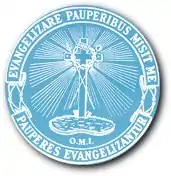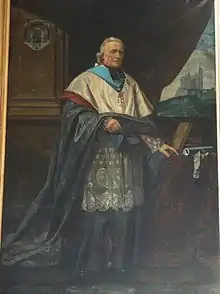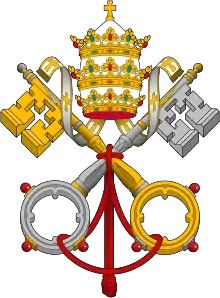Missionary Oblates of Mary Immaculate
The Missionary Oblates of Mary Immaculate (OMI) is a missionary religious congregation in the Catholic Church. It was founded on January 25, 1816, by Saint Eugène de Mazenod, a French priest born in Aix-en-Provence in the south of France on August 1, 1782. The congregation was given recognition by Pope Leo XII on February 17, 1826. The congregation is composed of priests and brothers usually living in community; oblate means a person dedicated to God or God’s service. Their traditional salutation is Laudetur Iesus Christus ("Praised be Jesus Christ"), to which the response is Et Maria Immaculata ("And Mary Immaculate"). In 2016, there were 3,924 members.[1]
 | |
| Abbreviation | OMI |
|---|---|
| Motto | Evangelizare Pauperibus Misit Me. Pauperes Evangelizantur (Latin) He has sent me to evangelize the poor. The poor are evangelized |
| Established | 1816 |
| Founder | Saint Eugène de Mazenod |
| Type | Missionary religious congregation |
| Headquarters | Via Aurelia 290 Rome, Italy |
Membership (2017) | 3,856 (2,892 Priests) |
Superior General | Rev. Fr. Louis Lougen, OMI |
Mission | to bring the Good News of Christ to the poor. |
| Affiliations | Roman Catholic |
| Website | OMI |
Formerly called | Missionaries of Provence |
History and charism

The Missionary Oblates of Mary Immaculate were founded in 1816 in Aix-en-Provence by Eugene de Mazenod. Born into the French minor nobility, his family were forced to flee to Italy during the French Revolution. There he experienced years of family instability, poverty, and danger. The family was forced to flee successively to Turin, Venice, Naples, and Palermo. Returning to France as a young man, he entered the Seminary of St. Sulpice and was ordained in 1811.[2]
On January 25, 1816, Father Eugene de Mazenod and four companions came together to preach missions in Provençal. The first members of this society were known as "Missionaries of Provence". They received the title of "Missionary Oblates of Mary Immaculate" and approbation as a congregation under simple vows in a Brief of Leo XII dated 17 February 1826.[3]
The congregation was established to renew the Church in France after the French Revolution. Their focus was primarily to
(1) Revive the spirit of faith among rural and industrial populations by means of missions and retreats, in which devotion to the Sacred Heart and to Mary Immaculate is recommended as a supernatural means of regeneration. "He hath sent me to preach the Gospel to the poor," has been adopted as the device of the congregation.
(2) Care of young men's societies, Catholic clubs.
(3) Formation of clergy in seminaries.[3]
However, the work of the congregation soon developed and the charism of the Oblates is that they "...are not specialised, except in facing urgent needs. ...It was enough for bishops to come to our Founder and say to him: "I do not have anybody" for him to act, re-examine his manpower, cut personnel here and there, and release 2 or 3 men for these new needs. And that continues today still. You see, it is a question of passion, of missionary concern.[4]
The ancient sanctuary of St. Martin of Tours was re-excavated and revived by Oblate Fathers under Cardinal Guibert in 1862.[3]
Vows
As members of a religious congregation, the Missionaries Oblates of Mary Immaculate embrace the evangelical counsels, taking the three traditional religious vows of poverty, chastity and obedience. Poverty means that all possessions are held in common and that no member may accumulate wealth. Chastity, abstaining from sexual activity, is intended to make the religious totally available for religious service.
Religious formation
The congregation’s Rule of 1853 makes a statement which still applies: "Whoever wishes to become one of us must have an ardent desire for his own perfection, and be enflamed with the love for Our Lord Jesus Christ and his Church and a burning zeal for the salvation of souls."[5]
In the initial stages, those interested in joining the congregation have several meetings with an OMI priest, usually with visits to a community. Young adults aged 18 and over meet regularly to share their experiences of God and what God may be calling them to become. During this time the members of the congregation share what it is like to be a priest or religious brother. Those who are enquiring about entering the congregation are strongly encouraged to attend Mass as often as possible, to read the Sacred Scriptures especially the Gospel accounts, and to regularly spend time in prayer in order to better discern their vocation.
Postulancy/Pre-novitiate
This is a 1-2 year experience of living in an OMI community, sharing in many aspects of the life of the congregation. During this time the postulants participate in the prayer life of a community, share more deeply with others, and become involved in one or more of the congregation’s apostolates. Essentially, it is an extended period of discernment for the postulants and an opportunity for the congregation to assess the strengths of the candidates and possible areas requiring growth. For those straight out of high school it is possible, in some provinces, to begin working on an undergraduate degree.[6]
Novitiate
Next follows the novitiate which is the time for preparing to take the vows of poverty, chastity, and obedience. The novices are given the opportunity for longer periods of prayer and spiritual reading as well as silence in order to reflect on the vocation God is offering and nature of their response. The spiritual development of the novice is of particular focus, especially through spiritual direction. During the novitiate the history and Constitutions of the Congregation are studied in depth. A simple profession is made at the end of the novitiate and the person officially becomes a member of the Congregation.
Post-novitiate/Scholasticate
After the novitiate, the new members of the congregation continue their studies. In the Philippines this normally involves a 4-year theology degree, followed by a missionary year abroad, although a student may make a request to study at the Pontifical Gregorian University in Rome.[6] The theologate in the United States is takes place in San Antonio, Texas, at Oblate School of Theology. In Canada, studies are undertaken at Saint Paul University in Ottawa, Ontario. Scholastics from four provinces in Southern Africa (Central, Lesotho, Natal, and Northern) study at the congregation’s scholasticate in the small town of Hilton in KwaZulu-Natal or at the international scholasticate in Rome.[7]
Vows are renewed annually; after three years a member may request final vows. According to canon law, temporary vows may be renewed for a longer period but not exceeding nine years.[8]
Missions
Pope Pius XI (1857-1939) was so impressed by the courage of the Oblates that he referred to them as “specialists in the most difficult missions of the Church.”[9] Indeed, regarding their ministry the Oblates declare:
We fulfill our task in healing the world by understanding its evolutionary character, by critically engaging its contemporary spirit, and by meeting its new needs in new ways.
We seek out and immerse ourselves in the lives of the most abandoned in their many faces and voices, and struggle with those most affected by conflicts.
With Gospel values we dialogue with peoples of different cultures, faiths, and religions, in the search for an integral transformation of society; we work with others to safeguard human dignity, nurture family, foster harmony, promote a culture of peace, and respond to the calls of justice and integrity of creation.[10]
The Oblates work in parishes, Catholic schools, retreat centres, and among indigenous peoples, emphasizing issues of justice and peace. The Oblates are active on five continents. They maintain a presence at a number of Marian Shrines including Lourdes, Our Lady of Snows, in Belleville, Illinois, Notre-Dame de Pontmain, France, and in Loreto, Italy.
In the UK and Ireland the Oblates work through parishes and Centres of Mission in London, Edinburgh, Anglesey and Dublin.[11]
Superiors General
Notable Oblates
Beati
- Blessed Joseph Gérard (1831–1914), French missionary priest, called the "Apostle of the Basuthos," beatified in 1988[12]
- Blessed Józef Cebula (1902–1941), Polish priest killed by the Nazis at Mauthausen concentration camp, beatified in 1999[12]
- Blessed Oblate Martyrs of Spain Bl. Francisco Esteban and companions Missionary Oblates of Mary Immaculate Martyrs beatified 2011
- The Martyrs of Laos, one Italian and five French missionary priests, beatified in 2016
Cardinals

- Joseph-Hippolyte Guibert (1802–1886), Archbishop of Paris
- Jean-Marie-Rodrigue Villeneuve (1883–1947), Archbishop of Quebec, Canada
- Thomas Cooray (1901–1988), Archbishop of Colombo, Sri Lanka
- Sebastian Koto Khoarai (born 1929), Bishop of Mohale's Hoek, Lesotho
- Francis George (1937–2015), Archbishop of Chicago
- Orlando Beltrán Quevedo (born 1939), Archbishop emeritus of Cotabato, Philippines
Bishops
- Vital-Justin Grandin (1829–1902), Bishop of St. Albert, Canada
- Alexandre-Antonin Taché (23 July 1823 – 22 June 1894) Roman Catholic Archdiocese of Saint Boniface, Canada
- Edmund Peiris (1897–1989), Bishop of Chilaw, Sri Lanka
- Denis Hurley (1915–2004), Archbishop of Durban, South Africa
- Hubert Constant (1931–2011), Archbishop of Cap-Haïtien, Haiti
- Erwin Hecht (1933–2016), Bishop of Kimberley, South Africa
- Benjamin de Jesus (1940–1997), Apostolic Vicar of Jolo, Philippines
- Victor Gnanapragasam (born 1940), Vicar Apostolic of Quetta,?Pakistan
- Roger Schweitz (born 1940), Archbishop of Anchorage, USA
- Jean Khamse Vithavong (born 1942), Vicar Apostolic of Vientiane, Laos
- David Douglas Crosby (born 1949), Bishop of Hamilton, Canada
- Mark Stuart Edwards (born 1959), Auxiliary Bishop of Melbourne, Australia; appointed Bishop of Wagga Wagga in 2020
- Gerard Tlali Lerotholi (born 1954), Archbishop of Maseru, Lesotho
- Carlos Salcedo Ojeda [obispo auxiliar arquidiócesis de Huancayo-Perú]
- Pierre-Olivier Tremblay (born 1970) Évêque auxiliaire de Trois-Rivières, Canada
Priests and religious
- Carl Kabat (born 1933), American priest and peace activist
- Albert Lacombe (1827–1916), French-Canadian missionary during the formation of Canada, broker of peace between the Cree and Blackfoot tribes
- Adrien-Gabriel Morice (1859–1938), linguist, cartographer, and ethnologist
- Émile Petitot (1838–1916), French cartographer and ethnologist
- Guy Mary-Rousselière (1913–1994) French-Canadian missionary priest, anthropologist and photographer, whose career was spent mostly in the Canadian Arctic.
- Ronald Rolheiser (born 1947), Canadian-born author of several spiritual books
- Larry Rosebaugh (1935–2009), American priest and activist
- Constantine Scollen (1841–1902), Irish-born missionary priest among the Blackfoot, Cree and Métis peoples of Canada and US.
Institutions
Americas
- The OMI founded the University of Ottawa in 1848, then the College of Bytown.[13] Since the University of Ottawa became publicly funded in 1965, Saint Paul University exists as a separate but federated institution with a pontifical charter to grant ecclesiastical degrees and a public charter, through the University of Ottawa, to grant civil degrees.
- The congregation has been involved in religious and secular publishing, helping to establish a number of church, community, and ethnic newspapers in Canada including Ottawa's francophone daily newspaper Le Droit.
- The Oblate School of Theology in San Antonio, Texas. Formerly, they ran a seminary in Pass Christian, Mississippi.
- The National Shrine of Our Lady of the Snows in Belleville, Illinois, along with its nearby retreat centre, King's House.
- The Colegio Vista Hermosa in Mexico City and several missions in the area of Oaxaca.
- The Oblates also opened and operated a mission school in 1863 in what was to be later named Mission, British Columbia. Its aim was to bring the indigenous people – the Sto:lo – to a Christian and agrarian lifestyle. Later, the school became a federally mandated residential school named St. Mary's and was closed in 1984, making it the last BC residential school to close. It is now operated as a cultural centre by the Sto:lo people.
- The Oblates opened and operated a mission school in Fort Albany, Ontario named St. Anne’s Indian Residential School. Members of the Oblates order have been alleged to have been involved in sexual and physical abuse of the students in the school.[14]
- Notre-Dame-du-Cap Basilica in Trois-Rivieres, the national shrine to the Holy Mother, and Canada's National Shrine to the Blessed Virgin Mary.
Australia
- Iona College, Brisbane
- Mazenod College, Victoria
- Mazenod College, Western Australia
- St Eugene College, Brisbane, Queensland
Philippines
Hong Kong
- Notre Dame College, Kowloon
- Oblate Primary School, Kowloon
- St Eugene de Mazenod Oblate Primary School, Kowloon
- Po Yan Oblate Primary School, Kowloon
RD Congo
Nigeria
- College De Mazenod Kihang, Bassa - Jos
South Africa
See also
- Oblate Youth Australia
- Notre Dame Broadcasting Corporation, a broadcasting network managed by the Philippine branch of the oblate
- Cavalry of Christ
Notes
- Annuario Pontificio (2017)
- Morice, Adrian. "Charles Joseph Eugene de Mazenod." The Catholic Encyclopedia Vol. 10. New York: Robert Appleton Company, 1911. 30 July 2018
 This article incorporates text from this source, which is in the public domain.
This article incorporates text from this source, which is in the public domain. -
 One or more of the preceding sentences incorporates text from a publication now in the public domain: Blanchin, François (1911). "Oblates of Mary Immaculate". In Herbermann, Charles (ed.). Catholic Encyclopedia. 11. New York: Robert Appleton Company. Retrieved 18 November 2017.
One or more of the preceding sentences incorporates text from a publication now in the public domain: Blanchin, François (1911). "Oblates of Mary Immaculate". In Herbermann, Charles (ed.). Catholic Encyclopedia. 11. New York: Robert Appleton Company. Retrieved 18 November 2017. - "Missionary Oblates of Mary Immaculate Australia > Charism & History > Oblate Charism". www.oblates.com.au. Retrieved 2017-07-17.
- "Who are We? The Inspiration", Oblate Communications
- "Oblates of Mary Immaculate > Join Us > Formation to Oblate Life". www.omiphil.org. Retrieved 2017-07-17.
- Natal Province: Formation
- "Code of Canon Law - IntraText". www.vatican.va. Archived from the original on 2017-07-06. Retrieved 2017-07-17.
- "Oblates of Mary Immaculate > About Us > The Mission Today". www.omiphil.org. Retrieved 2017-07-17.
- "Oblates of Mary Immaculate > About Us". www.omiphil.org. Retrieved 2017-07-17.
- "The Oblate Parishes in the UK and Ireland". Retrieved 2017-10-28.
- "Our Saints and Blessed", Missionary Oblates of Mary Immaculate, Assumption Province
- "Since 1848: About U of O". University of Ottawa. Retrieved 2009-10-09.
- Barrera, Jorge; Fortune, Lynette (March 4, 2019). "Police hunted for secret church archives during probe of abuse allegations at St. Anne's residential school". CBC News. Retrieved March 4, 2019.
- "Notre Dame University, Cotabato City". Archived from the original on 2007-09-28. Retrieved 2007-09-06.
- "Notre Dame of Greater Manila, Caloocan City". Archived from the original on 2006-04-11. Retrieved 2006-12-03.
References
- Carrière, Gaston (1957), Histoire documentaire de la congrégation des Missionnaires Oblats de Marie-Immaculée dans l'Est du Canada. Vol. 1., Ottawa, Ontario: Éditions de l’Université d’Ottawa
- Carrière, Gaston (1957), Dictionnaire biographique des Oblats de Marie-Immaculée au Canada. Vol. 1-3., Ottawa, Ontario: Éditions de l’Université d’Ottawa
External links
| Wikimedia Commons has media related to Missionary Oblates of Mary Immaculate. |
- Official website
- Oblate Missions in San Antonio Texas
- (Oblate) Missionary Association in Belleville, IL
- US Province Site
- Oblate School of Theology, San Antonio, Texas
- China Mission
- The Missionary Oblate of Mary Immaculate in Southern Africa
- Notre Dame of Marbel University a school under the administration of the Marist Brothers
- Notre Dame of Midsayap College
- Missionary Oblates of Mary Immaculate in Canada: OMI Lacombe
- Oblate Mission Centre (CMO), Montreal, Quebec, Canada
- Missionnaires Oblats de Marie Immaculée, Province du Cameroun
- Missionnaires Oblats de Marie Immaculée, Canada: Notre Dame-du-Cap, Québec
- Arctic Missionary Postcards at Dartmouth College Library
